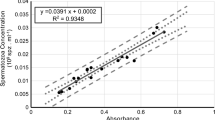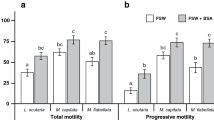Abstract
A simple sperm/fertilization bioassay, primarily using sea urchin (and sand dollar) gametes, was improved to yield a quick, sensitive, and cost-effective procedure for measuring toxicity in marine waters. Standard sperm bioassays are conducted by exposing sperm cells to test solutions for 60 min prior to addition of eggs to the test solution for fertilization. Reduced fertilization success (as indicated by the presence or absence of the obvious fertilization membrane) is used as an indicator of toxic effects on sperm viability and/or the fertilization response. This study, in conjunction with earlier work, has shown that the results of sperm bioassays can be affected by a number of factors including temperature, pH, salinity, sperm:egg ratios, sperm exposure times, test materials, and echinoid species. Each of these factors have been considered in designing the “standard” conditions for the improved test. Examples of the effect of these factors on the test results are illustrated, using silver as a reference toxicant.
Similar content being viewed by others
References
Axiak V, Saliba LJ (1981) Effects of surface and sunken crude oil on the behavior of a sea urchin. Mar Pollut Bull 12:14–19
Bernhard M, Zattera A (1970) The importance of avoiding chemical contamination for a successful cultivation of marine organisms. Helgolander wiss Meeresunters 20:655–675
Cleland KW (1953) Heavy metals, fertilization, and cleavage in the eggs ofPsammechinus miliaris. Exp Cell Res 4:246–248
Czihak G (1975) The Sea Urchin Embryo. In: Czihak G (ed) Biochemistry and Morphogenesis. Springer-Verlag, New York, 700 pp
Dinnel PA, Stober QJ, DiJulio DH (1981) Sea urchin sperm bioassay for sewage and chlorinated seawater and its relation to fish bioassays. Mar Environ Res 5:29–39
Dinnel PA, Stober QJ, Crumley SC, Nakatani RE (1982) Development of a sperm cell toxicity test for marine waters. In: Pearson JG, Foster RB, Bishop WE (eds) Aquatic Toxicology and Hazard Assessment: Fifth Conference, ASTM STP 766. Amer Soc Testing and Materials, Philadelphia, pp 82–98
Esposito A, Cipollaro M, Corsale G, Ragucci E, Giordano GG, Pagano GG (1984) The sea urchin bioassay in testing pollutants. In: Dov HJM, Giam CM (eds) Strategies and Advanced Techniques for Marine Pollution Studies. NATO, Brussels.
Finney DJ (1971) Probit Analysis, Third Edition. Cambridge Univ Press, Cambridge, MA, 333 pp
Giese AC, Farmanfarmaian A (1963) The resistance of the purple sea urchin to osmotic stress. Biol Bull 124:182–192
Greenwood PJ (1983) The influence of an oil dispersant Chemserve OSE-DH on the viability of sea urchin gametes. Combined effects of temperature, concentration and exposure time on fertilization. Aquatic Toxicol 4:15–29
Greenwood PJ, Bennett T (1981) Some effects of temperaturesalinity combinations on the early development of the sea urchinParechinus angulosus (Leske) fertilization. J Exp Mar Biol Ecol 51:119–131
Guidice G (1973) Developmental Biology of The Sea Urchin Embryo. Academic Press, New York, 469 pp
Hagström BE, Lönning S (1973) The sea urchin egg as a testing object in toxicology. Acta Pharmacologica et Toxicologica 32 (Supplement): 1–49
Hoadley L (1923) Certain effects of the salts of the heavy metals on the fertilization reaction inArbacia punctulata. Biol Bull 44:255–280
Hose JE (1985) Potential uses of sea urchin embryos for identifying toxic chemicals: Description of a bioassay incorporating cytologic, cytogenetic and embryologic endpoints. J Appl Toxicol 5:245–254
Hose JE, Puffer HW, Oshida PS, Bay SM (1983) Developmental and cytogenetic abnormalities induced in the purple sea urchin by environmental levels of benzo(a)pyrene. Arch Environ Contam Toxicol 12:319–325
Johnson FG (1979) The effects of aromatic petroleum hydrocarbons on chemosensory behavior of the sea urchin,Strongylocentrotus droebachiensis, and the nudibranch,Onchidoris bilamellata. PhD Dissertation, Univ Washington, Seattle, 110 pp
Kobayashi N (1971) Fertilized sea urchin eggs as an indicatory material for marine pollution bioassay, preliminary experiments. Publ Seto Mar Biol Lab 28:376–406
—. (1980) Comparative sensitivity of various developmental stages of sea urchins to some chemicals. Mar Biol 58:163–171
Linfield LT, Martin M, Norton J (1985) Bioassay species selection and recommended protocols. Marine Bioassay Project, First Progress Report Calif State Water Resources Control Board, Sacramento, CA, pp 77–86
Muchmore D, Epel D (1973) The effects of chlorination of wastewater on fertilization in some marine invertebrates. Mar Biol 19:93–95
Okubo K, Okubo T (1962) Study on the bio-assay method for the evaluation of water pollution—II. Use of the fertilized eggs of sea urchins and bivalves. Bull Tokai Reg Fish Res Lab 32:131–140
Oshida PS, Goochey TK, Mearns AJ (1981) Effects of municipal wastewater on fertilization, survival, and development of the sea urchin,Strongylocentrotus purpuratus. In: Vernberg FS, Calabrese A, Thurberg FP, Vernberg WB (eds) Biological Monitoring of Marine Pollutants. Academic Press, New York, pp 389–402
Pagano G, Esposito A, Giordano GG (1982) Fertilization and larval development of sea urchins following exposure of gametes and embryos to cadmium. Arch Environ Contam Toxicol 11:47–55
Pagano G, Esposito A, Giordano GG, Vamvakinos E, Quinto I, Bronzetti G, Bauer C, Corsi C, Niero R, Ciajolo A (1983) Genotoxicity and teratogenicity of diphenyl and diphenyl ether: A study of sea urchins, yeast andSalmonella typhimurium. Teratogenesis, Carcinogenesis and Mutagenesis 3:377–393
Pagano G (Personal communication) Istituto Nazionale Tumori, Via M Semmola 12, I-80131 Napoli, Italy
Renzoni A (1974) Influence of toxicants on marine invertebrate larvae. Thalassia Jugosiavica 10:197–211
Runnström J, Hagström B (1955) The effect of some oxidizing agents upon fertilization and ensuing development of the sea urchin egg. Exp Cell Res 7:327–344
Stebbing ARD, Åkesson B, Calabrese A, Gentile JH, Jensen A, Lloyd R (1980) The role of bioassays in marine pollution monitoring. Bioassay Panel Report. In: McIntyre AD, Pearce JB (eds) Biological Effects of Marine Pollution and the Problems of Monitoring. Rapports et Proces-Verbaux des Reunions 179:322–332
Stober QJ, Dinnel PA, Crumley SC (1979) Development of the echinoderm sperm bioassay for testing toxic substances. Final Report to US Environmental Protection Agency. FRI-UW-7922, Univ Washington, Seattle, 101 pp
Timourian H, Watchmaker G (1970) Determinations of spermatozoan motility. Devel Biol 21:62–72
Tyler A (1949) A simple non-injurious method for inducing repeated spawning of sea urchins and sand dollars. Collecting Net 19:19–20
—. (1963) Effects of ionizing radiation on sea urchin sperm and mechanism of fertilization. In: Carlson WD, Gassner FX (eds) Effects of Ionizing Radiation in the Reproductive System. Pergamon Press, New York, pp 287–295
Woelke CE (1972) Development of a receiving water quality bioassay criterion based on the 48-hour Pacific oyster (Crassostera gigas) embryo. Wash Dept Fish Tech Report No 9, Olympia, WA, 93 pp
Author information
Authors and Affiliations
Additional information
Contribution Number 699, School of Fisheries, University of Washington, Seattle, WA 98195, USA.
Rights and permissions
About this article
Cite this article
Dinnel, P.A., Link, J.M. & Stober, Q.J. Improved methodology for a sea urchin sperm cell bioassay for marine waters. Arch. Environ. Contam. Toxicol. 16, 23–32 (1987). https://doi.org/10.1007/BF01055356
Received:
Revised:
Issue Date:
DOI: https://doi.org/10.1007/BF01055356




